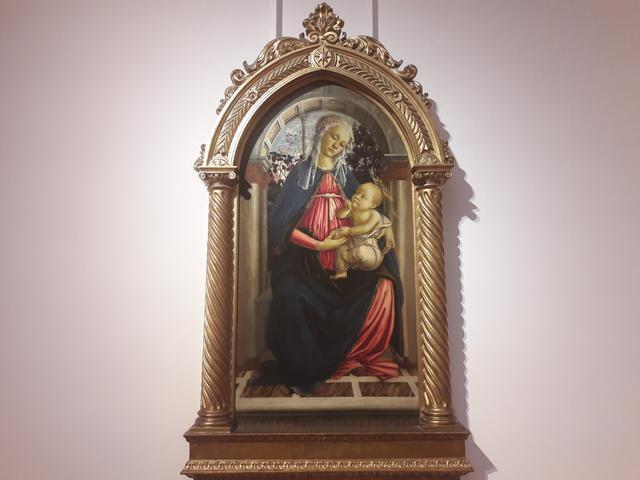Virgin of the rose garden

The Virgin of the Rose Garden is a tempera painting on panel (124x64 cm) made by Sandro Botticelli, whose date between 1469 and 1470 makes it one of his first paintings.
The work was housed in the Chamber of Commerce in Florence, leading to the hypothesis that, like Botticelli's earlier painting, the Madonna della loggia, it had been commissioned by the Wool Guild or the Tribunale della Mercanzia.
Wilhelm von Bode was the first to date the work to the artist's youthful phase, particularly to the Verrocchio period, 1469-1470, which has since been confirmed by other scholars.
The Virgin Mary, with a pensive attitude, holds the Child Jesus on her knees under a loggia with columns that support a semicircular arch with a coffered ceiling, framing the head of the Virgin and following the curved profile of the board. Behind Mary stretches a garden with its pink roses dominating the foreground. Below it is a framed marble tiled floor demonstrating the painter's mastery of the perspective technique.
The roses symbolize one of Mary's titles, "Mystical Rose." The pomegranate, which Mary holds in her hand and which the Child is tasting, symbolizes fertility, royalty and, with its red color, the blood of the Passion of Jesus.
The work displays the incisive use of chiaroscuro reminiscent of Verrocchio, in whose workshop Botticelli may have trained. The same type of child, with a large oval head and a cheerful, lively expression, can be seen in Verrocchio Putto's dolphin sculpture from the same period. The figure of Mary is elongated and vaguely posed, much more so than in the works of Filippo Lippi, another of the young Botticelli's models.
There are some uncertainties in the space, such as the disproportion of the architectural background which is too small compared to the figure of Mary and also compared to the flowers in the garden behind her.
© Tourblink